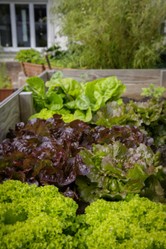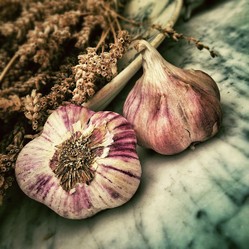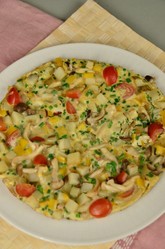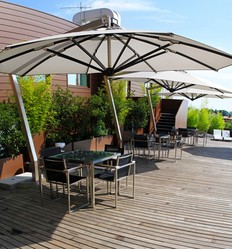As life changes, so do your activities. For more than twenty years I had been cultivating an allotment of 300 square yards through rain and shine, and all sorts of political and social situations. I had been on it one sunny day when news of the 9:11 atrocity broke. I still remember it clearly. So why have I gone down to a plot of 150 square yards? Easy to tell: a medical issue has forced a change. Let's look on the brighter side, I am nearly recovered. I have much less of the back pain than I used to have, but I have lost speed and strength, probably due to age. Gardens take a lot of work, especially when you specialize in vegetables, so I came to the conclusion that I needed to cut down my workload. Going down to half a plot made full sense, and the decision had the full support of my wife and family.
I had already divided the allotment into four: a flower bed at the front, behind which was a vegetable patch centred on some raised beds; then an orchard and greenhouse section, finally a wild section, which was nigh to the road with its large trees, the nearest of which was a pussy willow, known also as a weeping willow. The rear section was there for wildlife. I chose to keep the two rear sections, but obviously there was going to be changes.
Firstly, I was going to have to be more efficient in my use of space. For example, there was some underused space adjoining one of the greenhouses, which I had covered with a tarpaulin and used for storage. My son, Andrew, and I took up the tarpaulin, which was cumbersome rather than heavy, and shifted it onto the wild patch, for which I have plans. Then Iaid down some ground cover fabric to prevent weeds spring up on what was a piece of uncultivated soil. After that we moved some of the tyre planters onto the fabric, stacking them one atop another. I now have twelve tyres arranged in twos. This year I used them for pumpkins and have had a lovely pumpkin soup from them. Same again next year!
One move for which I needed help was to move the combined benches and picnic table. It was cumbersome, and we wanted to set it under the apple trees to make a shady nook for picnics. Getting it between the greenhouse and the trees was going to be tricky, but Andrew simply lifted it through. I also got some assistance in moving the raised beds, but there is still work to be done in laying geotextile fabric under them.
My plans for the wild section include planting some rhubarb in the compost heap. But to avoid having vegetables compete with tree roots I have begun placing containers on the tarpaulin to make a container garden. I will probably grow leeks, parsnips and carrots. There will still be some bits left wild for the butterflies.
There is still clearing to do, but as all crops are harvested there is none of the urgency of the growing season. It is time for a rest.










 Pilgrimage. A reviewon 06/15/2025
Pilgrimage. A reviewon 06/15/2025
 Leo the Fourteenthon 05/09/2025
Leo the Fourteenthon 05/09/2025
 The Melsonby Hoardon 03/25/2025
The Melsonby Hoardon 03/25/2025




Comments
I do not have any information on this mattter, but six inches seems a reasonable hypothesis
The first paragraph to the second subheading, My inspiration, considers the maraîcher vegetable-growers who "owned their own soil, so if they had to move on from a plot they took their soil with them."
Might there be an account or a reminiscence somewhere that notes how far down from surface-level was the soil that they placed among their belongings when they quit one place for another?
Might it have been as much as the top 6 inches (15.24 centimeters)?
Great.
Thank you!
It's supposed to be in the 80s Fahrenheit (26-plus degrees Celsius) today, tomorrow and Saturday. It's supposed to be in the 90s F (32-plus degrees C) -- with precipitation ;-{ -- Sunday and Monday.
So it'll be early tomorrow or Saturday or during the dinner hour Friday or Saturday that I'll go plant the seeds.
In particular, I like the reminder about leafy salad and littler edibles away from larger, robuster plants. The area around Stessily's porch must be smaller than the long stretch of the front-yard retaining wall (and of the back-yard one, which I omitted mentioning previously).
So there should be plenty of space for smaller around the porch and for substantialer along one or both walls.
Planting by families is the basis of crop rotation, but the problem is that some seeds of small plants are easily shaded out by larger and more vigorous plants. I am thinking of carrots, which are vulnerable in this respect. I like to grow carrots in pots or tubes. Small plants are easily shaded out by squashes. I would keep the smaller plants in a distinct area away from the larger and more vigorous ones.
As for asteraceae, I think that leafy salad crops are better in a distinct bed away from larger ones.
Good luck with your planting.
The seeds for the indoor gardening that I mentioned below got taken care of Memorial Day.
But I have more seeds than window boxes and pots! So my sister is agreeable to my planting them along her front-yard wall and around her front porch.
This weekend I may go over so that all the plants will be in the ground before or on July 4th.
How might arrangements of arugula with kohlrabi, mustard, radishes and turnips; beets with Swiss chard; carrots with parsnips, lettuce, onions and squashes fare?
I remember that some family members shouldn't be planted together.
Would that proscription apply to any of the above, which I have clustered by family?
(So Brassicaceae family members would be planted with Brassicaceae family members and the same would hold for Amaranthaceae, Apiaceae, Asteraceae, Amaryllidaceae and Cucurbitaceae family members.)
Also how would Asteraceae-family seeds fare near lettuce?
I have never heard of their bring grown indoors.
Thank you!
How would leeks fare inside?
Many plants grow well indoors, but seek out smaller varieties. Chives and lemon grass are good herbs. Fruits are hard to grow indoors. For flowers try alpines, which take well to indoor cultivation. Good luck with the project.
I'm thinking of doing some inside gardening, probably pots on the counter, pots on the floor and window boxes in the windows.
I expect to grow tomatoes. I'd love to grow squash but think that may be problematic. It would involve north-, south- and west-facing windows, with the most effective sunlight coming from the south.
What would you recommend in the way of flowers, fruits, herbs and vegetables?